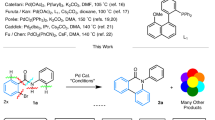Abstract
BETA aminoalcohols are not only used as drugs, such as ephedrine, chloramphenicol or pronethalol, but also occur naturally in animals and man, as adrenaline and noradrenaline, for example. It would be interesting to know whether these β aminoalcohols can be metabolised to aziridines, a class of carcinogenic compounds. Howe1 described the carcinogenicity of pronethalol (I) and supposed that the aziridine (II) could be the ultimate carcinogen (Fig. 1).
Similar content being viewed by others
References
Howe, R., Nature, 207, 594 (1965).
Wenker, H., J. Am. chem. Soc., 57, 2328 (1935).
Williams, R. T., in Biogenesis of Natural Compounds, second ed. (edit. by Bernfeld, P.) 589 (Pergamon Press, New York, 1967).
De Meio, R. H., and Lewycka, C., Endocrinology, 56, 489 (1955).
De Baun, J. R., Miller, E. C., and Miller, J. A., Cancer Res., 30, 577 (1970).
Bicker, U., Dissertation, German Academy of Science, (Berlin, 1972).
Preussmann, R., Schneider, H., and Epple, F., Azrneimittel-Forsch, 19, 1059 (1969).
Author information
Authors and Affiliations
Rights and permissions
About this article
Cite this article
BICKER, U., FISCHER, W. Enzymatic aziridine synthesis from β amino-alcohols—a new example of endogenous carcinogen formation. Nature 249, 344–345 (1974). https://doi.org/10.1038/249344a0
Received:
Issue Date:
DOI: https://doi.org/10.1038/249344a0
- Springer Nature Limited
This article is cited by
-
Ficellomycin: an aziridine alkaloid antibiotic with potential therapeutic capacity
Applied Microbiology and Biotechnology (2018)
-
Identification and characterization of the ficellomycin biosynthesis gene cluster from Streptomyces ficellus
Applied Microbiology and Biotechnology (2017)
-
Species differences in the metabolism of pamatolol, a cardioselective beta — adrenoceptor antagonist
European Journal of Drug Metabolism and Pharmacokinetics (1979)





